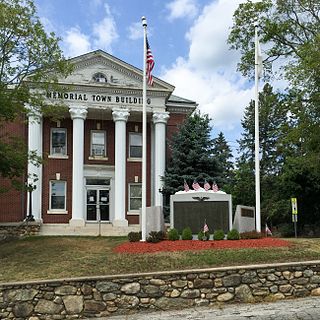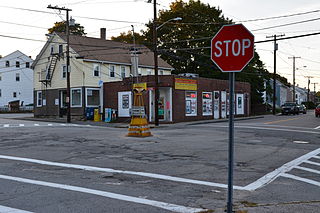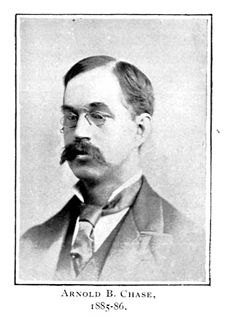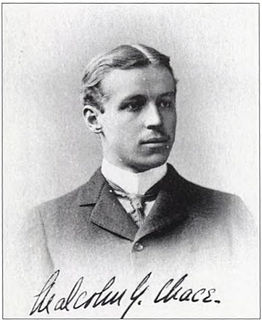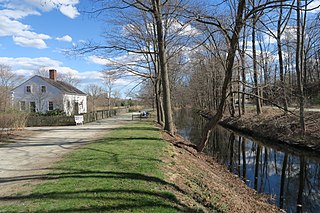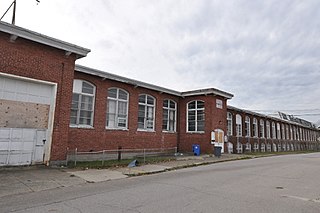

The Valley Falls Company was founded in 1839 by Oliver Chace, in Valley Falls, Rhode Island, a historic mill village on both sides of the Blackstone River, within the modern-day town of Cumberland and city of Central Falls, Rhode Island. [1] The Valley Falls Company is the original antecedent of Berkshire Hathaway, currently one of the world's largest and most successful companies.

Oliver Chace was an American 18th & 19th century businessman. He was the founder of several New England textile manufacturing companies in the early 19th century, including the Valley Falls Company, the original antecedent of Berkshire Hathaway, which as of today is one of the largest and most valuable companies in the world.

Valley Falls is a village and census-designated place (CDP) in the town of Cumberland, Providence County, Rhode Island, United States. The population was 11,547 at the 2010 census.

The Blackstone River is a river in the U.S. states of Massachusetts and Rhode Island. It flows approximately 48 mi (80 km) and drains a watershed of approximately 540 sq. mi (1,400 km²). Its long history of industrial use has left a legacy of pollution, and it was characterized by the United States Environmental Protection Agency in 1990 as "the most polluted river in the country with respect to toxic sediments."
Contents
Oliver Chace began his career as a carpenter working for pioneer industrialist Samuel Slater in Pawtucket, Rhode Island. Later, he would become influential in organizing several new mills, including one at Fall River, Massachusetts in 1813.
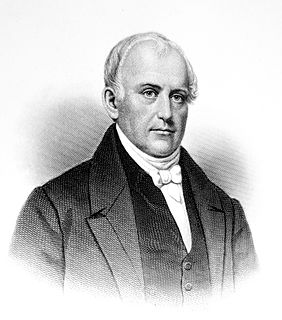
Samuel Slater was an early English-American industrialist known as the "Father of the American Industrial Revolution" and the "Father of the American Factory System". In the UK, he was called "Slater the Traitor" because he brought British textile technology to America, modifying it for United States use. He memorized the designs of textile factory machinery as an apprentice to a pioneer in the British industry before migrating to the United States at the age of 21. He designed the first textile mills in the US and later went into business for himself, developing a family business with his sons. A wealthy man, he eventually owned thirteen spinning mills and had developed tenant farms and company towns around his textile mills, such as Slatersville, Rhode Island.
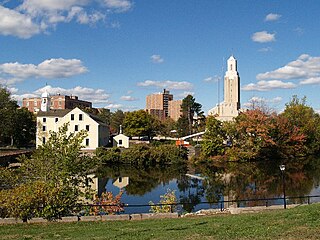
Pawtucket is a city in Providence County, Rhode Island, United States. The population was 71,148 at the 2010 census. It is the fourth largest city in the state.
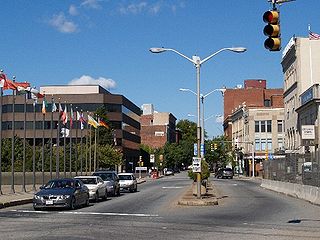
Fall River is a city in Bristol County, Massachusetts, United States. The City of Fall River is located approximately 53 miles (85 km) south of Boston, 17 miles (27 km) southeast of Providence, Rhode Island, 20 miles (32 km) south of Taunton, 12 miles (19 km) west of New Bedford, 20 miles (32 km) north of Newport, Rhode Island, 200 miles (320 km) northeast of New York City and 420 miles (680 km) northeast of Washington D.C.
The first textile manufacturing company at Valley Falls was established in 1818. By 1839, Oliver Chace was a very successful figure in the rapidly developing textile industry. He acquired and reorganized the Valley Falls mills, and eventually added two larger mills, one on each side of the river. His sons Samuel and Harvey would also be involved with expanding the company during this time. [2] The north side of the Village of Valley Falls grew to be the center of town government for the Town of Cumberland which it was located in. The town hall is located there today.
Textile manufacturing is a major industry. It is based on the conversion of fibre into yarn, yarn into fabric. These are then dyed or printed, fabricated into clothes. Different types of fibres are used to produce yarn. Cotton remains the most important natural fibre, so is treated in depth. There are many variable processes available at the spinning] and fabric-forming stages coupled with the complexities of the [Finishing (textiles)|finishing and colouration processes to the production of a wide range of products.
The southern part of the village of Valley Falls, originally part of Lincoln, Rhode Island, would eventually become part of the City of Central Falls in 1895.

Lincoln is a town in Providence County, Rhode Island, United States. The population was 21,105 at the 2010 census. Lincoln is located in northeastern Rhode Island, north of Providence. Lincoln is part of the Providence metropolitan statistical area and the Greater Boston combined statistical area.
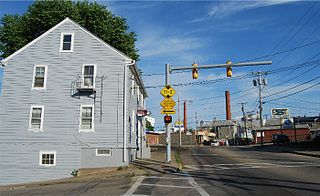
Central Falls is a city in Providence County, Rhode Island, United States. The population was 19,376 at the 2010 census. With an area of only 1.29 square miles (3.3 km2), it is the smallest and most densely populated city in the smallest state, and the 27th most densely populated incorporated place in the United States. It is also one of only four incorporated places in New England that have a higher population density than the city of Boston. The city takes its name from a waterfall on the Blackstone River.
The Valley Falls Company would eventually acquire the Albion Mills, Tar-Kiln Factory in Burrillville, Manville Mills in Rhode Island, and Moodus Cotton Factory in Connecticut. In 1929, the Valley Falls Company, and others would combine with the Berkshire Manufacturing Company of Adams, Massachusetts to become Berkshire Fine Spinning Associates. The Valley Falls mills were closed in 1930, and operations were moved elsewhere.

Rhode Island, officially the State of Rhode Island and Providence Plantations, is a state in the New England region of the United States. It is the smallest U.S. state by area, the seventh least populous, and the second most densely populated. Rhode Island is bordered by Connecticut to the west, Massachusetts to the north and east, and the Atlantic Ocean to the south via Rhode Island Sound and Block Island Sound. It also shares a small maritime border with New York. Providence is the state capital and most populous city in Rhode Island.

Connecticut is the southernmost state in the New England region of the northeastern United States. As of the 2010 Census, it has the highest per-capita income, Human Development Index (0.962), and median household income in the United States. It is bordered by Rhode Island to the east, Massachusetts to the north, New York to the west, and Long Island Sound to the south. Its capital is Hartford and its most populous city is Bridgeport. It is part of New England, although portions of it are often grouped with New York and New Jersey as the tri-state area. The state is named for the Connecticut River which approximately bisects the state. The word "Connecticut" is derived from various anglicized spellings of an Algonquian word for "long tidal river".

Adams is a town in northern Berkshire County, Massachusetts, United States. It is part of the Pittsfield, Massachusetts Metropolitan Statistical Area. The population was 8,485 at the 2010 census.
The mills on the Cumberland side were demolished in 1934 to avoid property taxes. The site remained vacant until 1991 when the Town of Cumberland and the Blackstone Valley National Heritage Corridor transformed the site into a historic park. Walkways, ramps and bridges meander along the steep slope and through the former mill site. Some of its foundations are still visible, as is the northern power canal trench.

Cumberland is the northeasternmost town in Providence County, Rhode Island, United States, first settled in 1635 and incorporated in 1746. The population was 33,506 at the 2010 census.
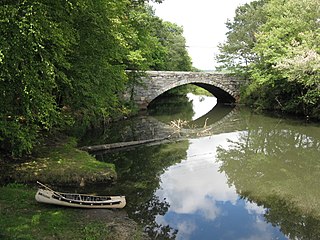
The Blackstone Valley or Blackstone River Valley is a region of Massachusetts and Rhode Island. It was a major factor in the American Industrial Revolution. It makes up part of the Blackstone River Valley National Heritage Corridor.
The 1855 brick mill on the southern, Central Falls side still remains, having been converted into senior housing in 1979; [3] it is listed on the National Register of Historic Places. It ranks as one of the earliest mill conversion projects in New England. Although the older mill closer to the river has been significantly altered and a large addition was built east of the main mill, it is still possible to observe the original power trench which flows through the mills, as well as the original brick mill tower. The gate house that directed water into the trench still stands by the dam. A similar structure once stood in the park on the Cumberland side of the falls, but is no longer standing. Parts of its foundation are still visible, as is the northern power canal.

